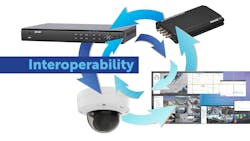When it comes to storing video, cost can add up quickly, especially as the industry moves to 4K cameras and beyond – requiring increased amounts of storage space and faster bitrate speeds. With increased storage needs and faster processing requirements, how can an integrator be sure their video solutions are the most cost-effective, without sacrificing video quality?
With ONVIF-conformant interoperable IP-based physical security products, an integrator can easily choose from more than 13,000 products to create the best possible combination of components for a video system.
The framework is established through profiles – such as Profile T, for advanced video streaming, H.265 video compression, and bidirectional audio streaming; and Profile G, for edge storage, search and playback. The concept of profiles – or groupings of related or commonly used features – enables end-users, system specifiers and designers and integrators to more easily identify features supported by a specific profile. For example, knowing that a product is ONVIF Profile T conformant enables the integrator to know that it will work with another Profile T device for activities such as streaming video, streaming audio and supporting PTZ functions without requiring in-depth technical knowledge of the product.
The freedom of choice to select the best and most appropriate camera or NVR for the project, and to ensure that future additions to the video system will continue to be compatible with existing equipment, is one of the key benefits of using conformant products.
When an integrator, for example, installs one brand of fixed network cameras to monitor a client’s office lobby and then uses PTZ units from another manufacturer in the parking lot, there will be confidence that both the Profile T conformant products will interface appropriately with the Profile G conformant video management systems and NVRs selected for the job – creating a seamlessly integrated solution from different vendors.
Designing a Complete Video and Storage Solution with Profiles G and T
By selecting products that are Profile T conformant, integrators and systems designers are able to select equipment armed with the knowledge of the specific features required for interoperability. Knowing that a product is Profile T conformant does not require knowledge of what is within that product, only that it will work with another Profile T device for activities such as streaming video, audio streaming and supporting PTZ functions. Most importantly, it will compress video – thus reducing overall storage needs and costs.
With Profile T in place, the integrator can also implement Profile G, a specification designed to store, search, retrieve and play back media on devices or clients that support recording capabilities and on-board storage, for a complete video and storage solution.
Profile G encompasses devices ranging from cameras and encoders to NVRs and video management systems, as well as those functions as included in such platforms as building management systems, physical security information management (PSIM) systems and other physical security systems.
By bringing video playback into the profile concept and into ONVIF global interface specifications, it becomes much easier for end-users, integrators, consultants and manufacturers to harness network video technology, while simultaneously cuttings costs and staying on the cutting edge of new technologies.
With the finalizations of Profile G and Profile T, ONVIF has completed the circuit, providing the means whereby product manufacturers and software developers can present at a basic level an integrated video and access control system. This is a true complement to our existing Profiles and takes standardized interoperability to new heights.
H.265 and ONVIF Profile T
Profile T employs a new media service that is compression agnostic. This means that it can support new video compression formats, including H.265, as well as new audio compression formats, with the ability to include new video and audio codecs as needed in the future without having to redesign its media service.
A video management system’s ability to provide analysis, real time event notifications and crucial image detail is only as a good as the speed and bandwidth of a surveillance network. With the development of Profile T, users are given more opportunities to utilize profiles together and create the best, most future-proof surveillance system possible.
Reduced bandwidth and storage requirements are the primary benefits of video compression technologies, and the main feature of Profile T. In some cases, H.265 can double the data compression ratio of the widely used H.264, while retaining the same quality. Increased compression rate translates into decreased storage requirements on hard drives, less bandwidth usage and fewer switches – all of which reduce overall costs of system ownership. H.265 compression delivers a lower bitrate than H.264, reducing playback issues and the strain on hardware. ONVIF believes H.265 will become the most widely used compression format on the market, and has developed a migration path that will serve the industry well into the future.
Collaboration of Profiles
With Profile T, Profile G and potentially Profile S working in conjunction to provide a connected solution, end-users can have peace of mind that their video data is being stored and retrieved as quickly as possible. This enables users to react to events as soon as they happen, and ensures all systems are communicating properly and efficiently.
Profile T further enables customers to choose the products that work best for their needs, while simultaneously analyzing which parts of an image are most important and adjusting local levels of compressions accordingly, thanks to H.265 capabilities. Profiles complementing profiles means the market will soon have the potential for untapped interoperability capabilities.
While Profile G and Profile T are related, the two are independent profiles that encompass different functionalities of a network video system. Profile T helps to connect more head-end devices and eases the processing of video, while simultaneously providing video compression for a reduction in storage costs.
Profile G broadens the potential of an ONVIF system even further by making recording and storage available on devices. Most clients may implement both profiles, such as a camera with onboard storage or a digital video recorder. While a camera may implement Profile T for transmission of video, an NVR would encompass the functionalities from Profile G.
The Future
As ONVIF continues to meet the demands of the market through the release of profiles, users who conform to the ONVIF standard can remain confident that their systems are fast, future proof and the most cost-effective option available. Conformance means never being tied down to a single manufacturer agreement, and in turn, means freedom of choice. With multiple profiles now supporting storage needs, the interoperability of products is more crucial than ever when implementing a future-proof system in order to keep costs low and keep the system relevant.
In addressing the issue of standardization, and responding to the ever-changing needs of the market, ONVIF is constantly evolving, adding new profiles and spurring companies to expand their portfolios of conformant offerings.
Per Björkdahl is Chairman of ONVIF’s Steering Committee. Learn more about ONVIF at www.onvif.org.



